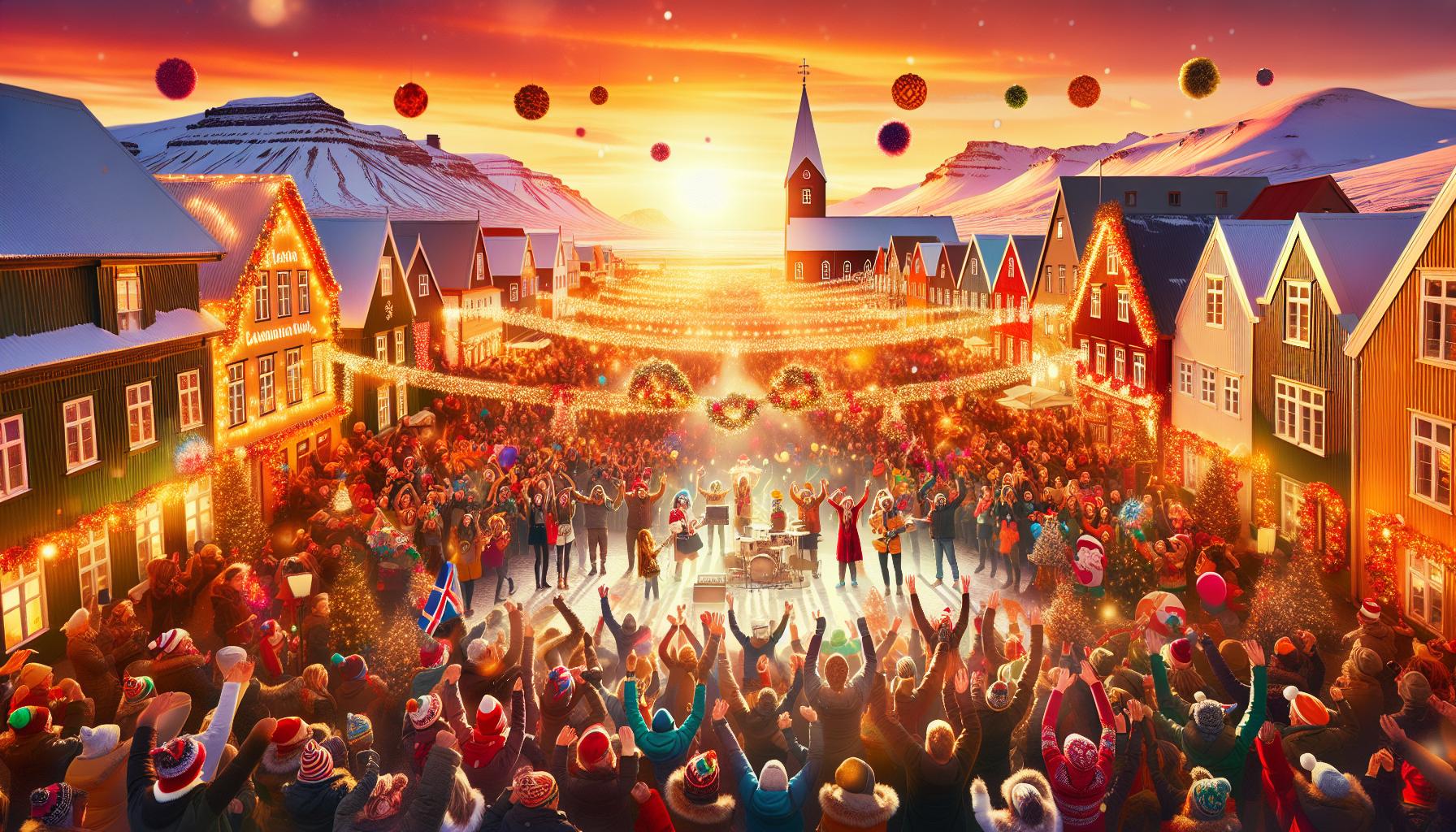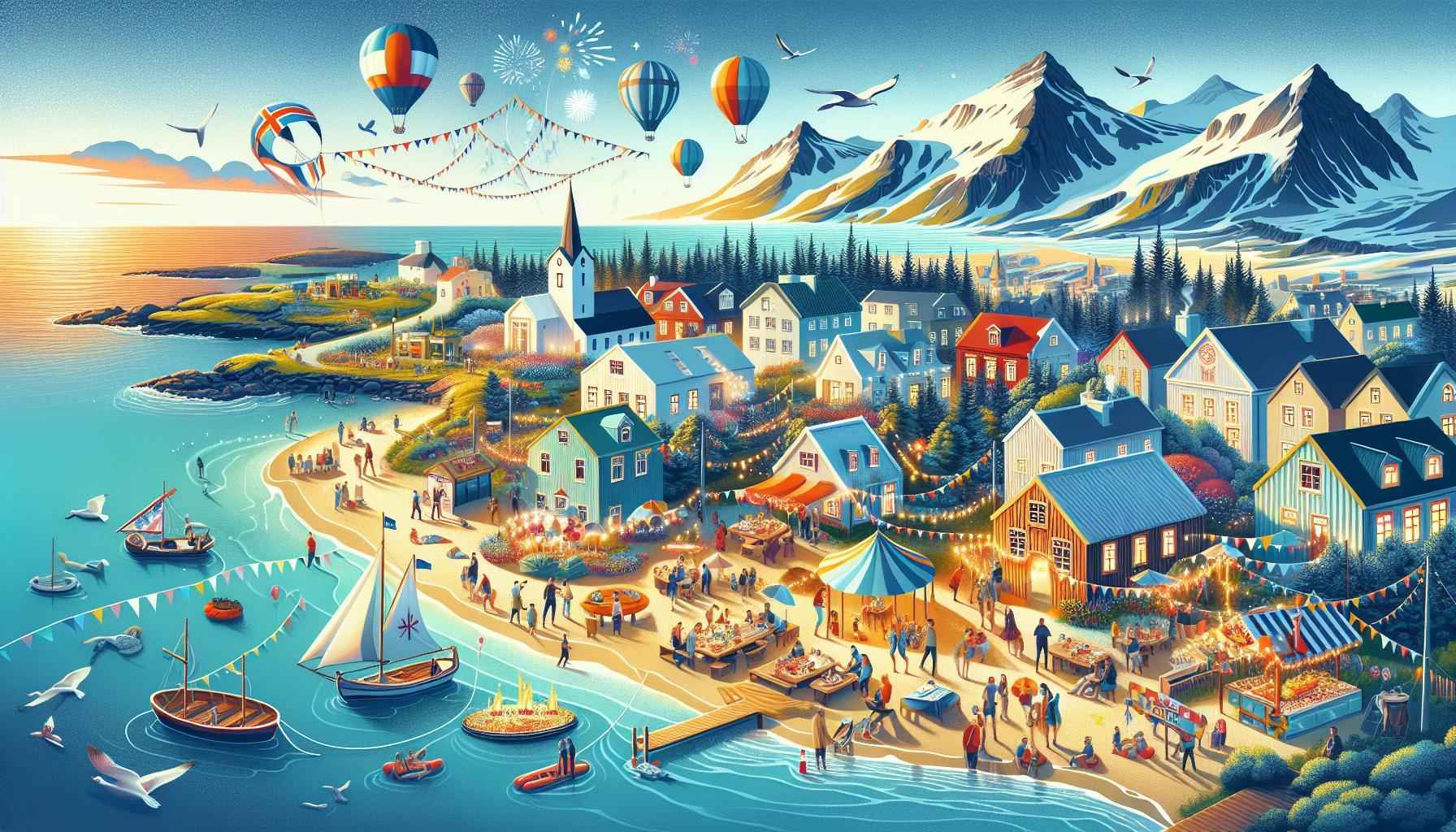Iceland’s unpredictable climate can leave many travelers wondering just how cold it really gets throughout the year. Understanding the country’s unique weather patterns is crucial for planning your visit, ensuring you’re prepared for everything from sudden snowstorms to balmy summer days. With this guide, you’ll navigate Iceland’s seasons like a pro, making the most of your adventure.
Understanding Iceland’s Four Distinct Seasons: What to Expect Year-Round

In a land where nature reigns supreme, Iceland showcases an enticing variety of climates and experiences throughout the year. Each season provides unique opportunities and challenges for travelers. Understanding these distinctions can greatly enhance your journey, from the enchanting hues of summer to the stark beauty of winter. This year-round weather guide reveals what to expect in each season, ensuring you are fully prepared for your Icelandic adventure.
Spring (March to May)
As winter recedes, spring brings a gradual warming, typically between 0°C and 15°C (32°F to 59°F). This season is magical for wildlife enthusiasts, as it marks the return of puffins to the coastal cliffs. During this time, you can expect to witness breathtaking blooms and fresh greenery, especially around May. Spring is also a quieter travel period, allowing for a less crowded experience at popular destinations. Pack layers, as weather can change rapidly and be prepared for some lingering snow in the highlands.
Summer (June to August)
Characterized by long days and the midnight sun, summer is the most popular time to visit Iceland. Temperatures range between 10°C and 20°C (50°F to 68°F) and the landscape bursts into life with vibrant colors. This season is ideal for outdoor adventures such as hiking, camping, and exploring the renowned Blue Lagoon. The mild weather and extended daylight hours allow travelers to make the most of their time. However, as summer attracts swarms of tourists, consider booking accommodations and tours in advance to secure your spot.
Autumn (September to November)
As summer gives way to autumn, the scenery transforms into a palette of vibrant reds and golds. Temperatures begin to dip, averaging between 5°C and 10°C (41°F to 50°F). Autumn is an excellent time for photography, capturing the stunning fall foliage and the return of the Northern Lights. Visitors will encounter fewer crowds and can enjoy the tranquility of Iceland’s natural wonders. Be mindful of changing weather conditions, as early snow can happen, particularly in late October.
Winter (December to February)
Experiencing Iceland in winter offers a different kind of magic. With temperatures hovering around -1°C to 5°C (30°F to 41°F), the landscape becomes a frosty wonderland. This season is ideal for Northern Lights chasing, as nights are long and dark. Travelers can explore ice caves, glacier hikes, and partake in winter sports. It’s crucial to dress warmly in layers and embrace the charm of Iceland’s winter festivities. Despite the cold, winter provides some of the most unique landscapes and experiences for those willing to brave the chill.
By understanding Iceland’s four seasons, you can choose the best time to align your travel plans with your interests, whether you’re seeking the midnight sun of summer or the ethereal glow of the Northern Lights in winter. This year-round weather guide serves as your compass to navigate the breathtaking seasons of Iceland effectively.
The Cold Reality: Average Temperatures Monthly and What They Mean for Travelers
When planning a visit to Iceland, it’s essential to understand how the country’s temperatures fluctuate throughout the year and what those fluctuations mean for your travel experience. Iceland’s unique geographical location and its proximity to the Arctic Circle create a climate that can be both captivating and challenging. From the chill of winter to the milder temperatures of summer, knowing what to expect month by month will enhance your adventure.
Monthly Average Temperatures
The average temperatures in Iceland vary significantly from month to month, significantly influencing travel opportunities and experiences:
| Month | Average Max Temp (°C) | Average Min Temp (°C) |
|---|---|---|
| January | 1 | -3 |
| February | 1 | -4 |
| March | 2 | -3 |
| April | 5 | 0 |
| May | 8 | 3 |
| June | 12 | 7 |
| July | 14 | 9 |
| August | 13 | 9 |
| September | 10 | 6 |
| October | 6 | 3 |
| November | 3 | -1 |
| December | 1 | -3 |
As seen in the table, winter months (December through February) are notably cold, making activities like snowmobiling and exploring ice caves popular. Conversely, summer (June to August) offers warmer temperatures, ideal for hiking and enjoying outdoor festivals. Travelers should prepare for sudden weather changes, particularly in May, where temperatures can range from 3°C to 8°C with increased rainfall. This transition month is marked by extremes, as the land shifts from the chill of spring to the welcoming warmth of summer, often leading to unpredictable weather conditions.
Travel Tips for Different Seasons
Adapting your travel plans to align with Iceland’s climate is vital. Here are some practical tips for various seasons:
- Winter (December – February): Dress in layers, and ensure your winter gear includes waterproof clothing and sturdy boots.
- Spring (March – May): Expect a mix of rain and sun; pack a light rain jacket and sturdy footwear for hiking.
- Summer (June – August): While days are longer, nights can be chilly; bring a warm jacket and enjoy the bright nights.
- Autumn (September – November): This season can be unpredictable; layering is key, along with waterproof apparel for sudden showers.
Understanding how cold it gets in Iceland, as outlined in the year-round weather guide for travelers, empowers visitors to make the most of their journeys while enjoying all the natural beauty and cultural experiences the country has to offer.
Beyond the Frost: Exploring Iceland’s Stunning Seasonal Landscapes

The dynamic landscapes of Iceland tell a tale of transformation, shaped by both volcanic activity and glacial movements. As travelers venture beyond the icy surface, they discover a realm where each season unveils a new aspect of its breathtaking beauty. From lush greens in the summer to the stark whites of winter, Iceland offers a mosaic of stunning views that captivate photographers, nature lovers, and adventurers alike.
Summer’s Vibrant Tapestry
During the summer months, Iceland bursts into life with a palette of greens, blues, and florals. The prolonged daylight hours create perfect conditions for exploring the island’s rich landscapes, including its stunning fjords and scenic routes. Popular destinations such as the Golden Circle and the South Coast reveal cascading waterfalls, geysers, and expansive agricultural lands. Travelers can embark on hikes through the colorful highlands, where fields of wildflowers are framed by dramatic mountains.
– Best time for hiking: Late June to early September, when trails are accessible.
– Key spots to explore: Þingvellir National Park, Gullfoss waterfall, and the vibrant Landmannalaugar region.
Autumn’s Golden Glow
As summer wanes, Iceland transitions into autumn, painting the landscape in golds and russets. This season is perfect for exploring the stunning contrasts of the land and taking advantage of fewer crowds. Hikers can enjoy mild temperatures while witnessing the dramatic changes in foliage. The northern lights begin to dance across the sky in September, offering a mesmerizing experience for night sky enthusiasts.
– Tip: Visit in late September for the best chance to see the northern lights while enjoying fall foliage.
Winter’s Serene Stillness
With winter’s arrival, Iceland transforms into a hushed, ethereal wonderland. The landscape is cloaked in snow, and glaciers glimmer under the pale winter sun. Ice caves and frozen waterfalls become accessible for those daring enough to venture out. This is also the ideal time for photographers who wish to capture the stark beauty of Iceland’s natural features, including the famous Blue Lagoon or the otherworldly Jökulsárlón glacier lagoon.
– Must-see sights:
– Ice caves in Vatnajökull National Park.
– The enchanting frozen waterfalls of Gullfoss.
Spring’s Awakening
As the frost thaws, the spring months breath life back into the surroundings. This transitional period is marked by blooming flora and revitalized wildlife—a perfect time for birdwatching enthusiasts. The stunning contrasts of melting snow against emerging greenery provide a unique backdrop for captivating photography.
– Optimal activities:
– Witness the migration of seabirds along the coastal cliffs.
– Explore geothermal areas as they come alive with color.
| Season | Highlights | Activities |
|---|---|---|
| Summer | Lush landscapes, midnight sun | Hiking, sightseeing, whale watching |
| Autumn | Vibrant foliage, northern lights | Hiking, photography, aurora viewing |
| Winter | Snow-covered scenery, ice caves | Ice climbing, glacier tours, northern lights |
| Spring | Blooming flora, migratory wildlife | Birdwatching, hiking, geothermal exploring |
Each season in Iceland not only showcases the country’s diverse and stunning landscapes but also offers unique adventures tailored to every type of traveler. Whether following the vibrant summer trails or marveling at the serene beauty of winter, Iceland’s environments are reminders of the dynamic forces of nature at play. Understanding these shifts is integral for visitors seeking the most immersive experiences while navigating the varied weather patterns as outlined in the year-round weather guide.
Embracing the Chill: Essential Gear for Your Icelandic Adventure

Iceland is known for its stunning landscapes and dramatic weather changes, where temperatures can fluctuate even within the same day. To fully enjoy the diverse outdoor experiences, visitors must be equipped with the right gear to embrace the chill. Whether you’re gazing at the Northern Lights or exploring rugged terrains, having proper clothing can make a significant difference in comfort and enjoyment.
Layering is Key
When preparing for the varying temperatures, a layered clothing system is indispensable. This method allows you to adjust your insulation throughout the day easily. Here’s a guide to each layer:
- Base Layer: Opt for moisture-wicking materials like merino wool or synthetic fibers. Avoid cotton, as it retains moisture.
- Mid Layer: Insulating layers such as fleeces or down jackets can retain warmth. Consider packable options for convenience.
- Outer Layer: A waterproof and windproof shell is essential. Look for jackets with breathable fabrics to prevent overheating during activities.
Don’t Forget Your Accessories
Proper accessories can be the difference between a pleasant adventure and an uncomfortable ordeal. Invest in high-quality gear that covers all extremities:
- Hats and Gloves: Choose insulated and waterproof options. Mittens typically keep your hands warmer than gloves.
- Scarves and Neck Gaiters: These protect your neck and face from biting winds while providing additional warmth.
- Socks: Wear thick wool socks for warmth. Consider bringing multiple pairs to keep your feet dry and comfortable.
Footwear Matters
Iceland’s terrain can be challenging, requiring sturdy, waterproof hiking boots for trails and excursions. Look for features like:
- Grip: A good tread pattern can prevent slips on wet or rocky surfaces.
- Insulation: Insulated boots will keep your feet warm in colder conditions, especially during winter.
- Waterproofing: Prioritize boots with Gore-Tex or similar waterproof membranes to keep your feet dry.
By considering these essential gear items, you’ll be better prepared to face the unpredictable weather and embrace the natural beauty of Iceland. Following the insights from the “How Cold is Iceland: Year-Round Weather Guide for Travelers,” you will find that with the right preparation, you can explore Iceland comfortably, regardless of the chill in the air.
The Icelandic Weather Whirlwind: Preparing for Sudden Changes

The unpredictable nature of Iceland’s weather is both a challenge and an adventure for travelers. Nestled between the North Atlantic and Arctic Oceans, this island nation’s climate is characterized by sudden changes that can turn a sunny day into a snowstorm in mere minutes. This dynamic weather system is influenced by geographical features, ocean currents, and the temperamental seasons, making it essential for visitors to be prepared for whatever Mother Nature throws their way.
Understanding the Patterns
In May, expect a typical range of temperatures from roughly 4°C to 10°C (39°F to 50°F), but don’t be misled by an otherwise calm morning. The Icelandic weather can shift dramatically; going from drizzling rain to surprising sunshine is a hallmark of this time of year. This mix is a product of unpredictable weather fronts battling across the island, especially in the spring when winter begins to yield to summer. It’s advisable to check reliable forecasts daily and maintain a flexible itinerary when planning outdoor activities.
What to Pack for the Changeable Climate
When assembling your travel wardrobe for Iceland, remember the golden rule: layers, layers, layers. Here are some essentials to include:
- Waterproof outer layer: A good raincoat or windbreaker is essential to protect against sudden downpours.
- Warm underlayers: Thermal tops and leggings will keep your body heat in, especially during colder evenings.
- Sturdy footwear: Waterproof boots with good grip are crucial, particularly if you plan to explore rugged terrains.
- Accessories: Don’t forget a warm hat, gloves, and a scarf; these can be lifesavers against biting winds.
Planning for Activities
Given the potential for sudden weather swings, it’s wise to plan activities that can accommodate changes. For instance, if a hiking trail becomes inaccessible due to rain, having a backup plan such as visiting geothermal spas or local museums can ensure your day isn’t a washout. Many travelers recommend keeping a list of indoor attractions, as well as quick-access nature spots that could remain stunning even in less-than-ideal conditions.
Table of Average Weather Conditions in May
| Weather Feature | Average Range |
|---|---|
| Temperature | 4°C to 10°C (39°F to 50°F) |
| Precipitation | About 88mm |
| Daylight Hours | Approx. 18 hours |
By understanding the robust nature of Icelandic weather and adequately preparing for its unpredictability, you can turn those potential inconveniences into memorable, exhilarating experiences. Whatever the conditions, each unexpected twist of the weather adds to the rich tapestry of your Icelandic adventure, showcasing the country’s raw beauty and wild charm.
Daylight Hours in Iceland: The Impact of Seasons on Your Travel Plans

Experience daylight like never before in Iceland, where seasonal changes dramatically affect the hours of sunlight available to travelers. As you plan your journey using the insights from the comprehensive ‘How Cold is Iceland: Year-Round Weather Guide for Travelers’, understanding the daylight variations will be key to maximizing your adventures.
Winter: Limited Sunlight
During the depths of winter, specifically from late November to mid-January, daylight hours are at their shortest. Travelers can expect only about 4-5 hours of light each day. The sun rises around 11:30 AM and sets before 4 PM, which may limit the number of activities you can undertake. However, this is also the prime season for witnessing the mesmerizing Northern Lights, which can create a magical atmosphere under the starry night sky. To make the most of the limited daylight, consider planning shorter excursions that align with the sun’s schedule, such as visiting geothermal pools or exploring the vibrant city of Reykjavik during the light hours.
Spring: Increasing Light
As spring approaches, daylight hours in Iceland rapidly increase. By March, visitors can enjoy around 11 hours of daylight, with sunrises at about 8:30 AM and sunsets around 6:45 PM. This noticeable change in lighting sets the stage for exciting outdoor activities. The thawing landscape unveils breathtaking views and allows for exploration of the iconic Golden Circle, including Þingvellir National Park and the Geysir hot springs. Planning a road trip during this season means you can indulge in longer days filled with sightseeing, making it an optimal choice for those eager to experience Iceland’s stunning nature.
Summer: The Midnight Sun
From late May to early August, Iceland experiences the phenomenon of the midnight sun, where daylight can stretch up to 24 hours. This is the perfect time for travelers looking to maximize their adventures, as you can embark on hikes in the late evening and appreciate the breathtaking sunsets that blend into sunrises. May brings around 17 hours of sunlight, with the sun setting just after midnight and rising again early in the morning. Use this time to explore remote areas, enjoy camping under the open sky, or participate in festivals that celebrate the midnight sun.
Fall: A Transition to Darkness
As autumn approaches, daylight hours begin to decrease once again. In September, daylight lasts approximately 12 hours, with the sun setting around 8 PM. This season is characterized by stunning fall colors, making it an ideal time for photography enthusiasts. With days gradually shortening, early fall is an excellent opportunity to enjoy both day and night activities without the overwhelming crowds that summertime brings. To plan effectively, consider booking tours that allow you to experience both daylight and evening activities, such as visiting local hot springs and enjoying the twilight ambiance.
Understanding how daylight hours fluctuate throughout the year is critical for crafting a fulfilling travel itinerary in Iceland. By aligning your travel plans with the seasonal light patterns outlined in the ‘How Cold is Iceland: Year-Round Weather Guide for Travelers’, you can make the most of every moment in this stunning destination.
Socializing in the Cold: How Locals Make the Most of Iceland’s Winter
In the depths of winter, when the snow blankets the landscape and the days are short, Icelanders embrace the cold with a spirited social calendar far from the isolation one might expect. The winter months serve as a backdrop for rich community interactions, where warmth comes not just from the indoor heat but from strong social ties. Locals often derive joy and purpose from activities that bring friends and family together, ensuring that despite the chilly weather, a sense of belonging flourishes across the country.
Community Activities and Gatherings
During winter, organized social life becomes a central feature of Icelandic culture. Weekly activities such as game nights, book clubs, and various sports events lure people out of their homes. These gatherings allow friends and neighbors to bond over shared interests, creating traditions that last through generations. For example, community centers often organize events that not only entertain but also foster skills, such as cooking classes focused on traditional Icelandic dishes, or even arts and crafts workshops that help nurture local talent.
- Game Nights: A staple in many households, these evenings are perfect for catching up and enjoying friendly competition.
- Choirs and Music Groups: Music plays a significant role in local culture, with many joining choirs or bands to fill dark winter nights with song.
- Volunteering Opportunities: Many Icelanders participate in community service, which offers a rewarding way to connect with others while giving back.
Cultural Events and Festivals
Moreover, winter in Iceland is not devoid of excitement; various cultural events pepper the calendar, keeping spirits high. Festivals like the Reykjavik Winter Lights Festival and the Thor’s Day Celebration present fantastic opportunities for locals and visitors alike to engage in unique Icelandic traditions. These events frequently feature art installations, performances, and local cuisine, promoting a sense of pride in their heritage and providing social hubs where everyone can connect.
Warmth in the Winter Air
The concept of ‘hygge,’ or cozy comfort, permeates social gatherings. Homes are often filled with the scent of pastries and hot beverages, creating inviting spaces where camaraderie thrives. As locals gather, they share stories that are as rich as the landscape outside. This blend of warmth and community effectively combats the winter blues, making the cold months not merely survivable but enjoyable. Understanding how locals make the most of winter life can enrich any traveler’s experience, turning a visit during this season into a memorable adventure.
With these vibrant community connections and shared experiences, visitors can gain insight into the Icelandic way of life, enriching their understanding of how to navigate the chill as suggested in the ‘How Cold is Iceland: Year-Round Weather Guide for Travelers’. Embracing the local culture offers a unique perspective on winter in Iceland, making any trip during these months truly special.
Finding Warmth: Best Indoor Attractions and Cozy Cafés in Iceland
Exploring Iceland’s vibrant indoor attractions and cozy cafés offers a delightful escape from the often chilly and unpredictable weather. When the cold sets in, these indoor gems not only provide warmth but also immerse visitors in Icelandic culture and comfort. Whether you seek art, history, or simply a hot drink, the capital city of Reykjavík is rich with options that create a perfect respite from the cold.
Must-Visit Indoor Attractions
Start your journey at the Perlan Museum, a stunning structure featuring a range of interactive exhibitions. Here, you can explore Iceland’s natural wonders, including a recreated ice cave and exhibits about volcanoes and glaciers. Another fantastic spot is the Kjarvalsstaðir Art Museum, where you can marvel at the works of Icelandic painter Jóhannes S. Kjarval, whose pieces reflect the unique Icelandic landscape and culture [[2](https://visitreykjavik.is/see-and-do/activities/indoor-activities)].
For an immersive experience, consider visiting Aurora Reykjavík, a unique exhibition dedicated to the Northern Lights. This engaging space blends education with stunning visuals, perfect for those who didn’t get a chance to witness this natural phenomenon in the cold winter sky.
Cozy Cafés to Warm Up
After a day of exploring, retreat to one of Reykjavík’s many inviting cafés. Notable options include:
- Café Babalú – Known for its eclectic décor and cozy atmosphere, serving delicious pastries and hot beverages.
- Te & Kaffi – A local favorite offering a wide selection of coffees and teas to keep you warm.
- Stofan Café – This café is perfect for relaxing with a book or simply enjoying the cozy ambiance, complete with comfy seating.
These cafés serve as perfect havens, allowing you to warm up while savoring traditional delicacies such as cinnamon rolls or Icelandic hot chocolate.
Finding warmth in Iceland is not just about escaping the cold; it’s about immersing yourself in the rich tapestry of Icelandic life. With so many indoor attractions and cozy cafés, you can embrace the chilly weather outside while enjoying the warmth of culture and community inside. Whether you’re navigating through the cold of winter or simply enjoying a rainy day, these options called indoors will enrich your experience as outlined in the “How Cold is Iceland: Year-Round Weather Guide for Travelers.”
How to Experience the Northern Lights: Planning Your Visit Around Weather Conditions
Witnessing the mesmerizing northern lights in Iceland is an experience like no other, but planning your visit requires a keen understanding of the local weather conditions. The climate can be unpredictable, and successful aurora spotting often hinges on clear skies and low light pollution. As highlighted in the comprehensive insights from “How Cold is Iceland: Year-Round Weather Guide for Travelers,” understanding seasonal weather patterns will greatly enhance your chances of witnessing this breathtaking natural phenomenon.
When selecting the best months for your adventure, aim for September through April, as these months offer the highest likelihood of clear skies essential for northern lights viewing. During these months, temperatures can vary significantly, so being prepared for the cold is crucial. The average temperature during winter months can dip below freezing, making it vital to dress in layers. Aim for thermal undergarments, insulated jackets, hats, gloves, and waterproof boots to combat the chill while you’re outside under the night sky, waiting for the auroras to dance overhead.
Weather Conditions to Monitor
To optimize your northern lights viewing experience, being aware of real-time weather updates is key. Here are some conditions to monitor before heading out:
- Cloud Cover: The clearer the sky, the better your chances of seeing the lights.
- Precipitation: While a light drizzle might not be a dealbreaker, heavy rain or snow can obstruct visibility.
- Wind Speed: High winds can create a chilling effect, so be prepared for bitter windchill when venturing outdoors.
Tracking these factors will also allow you to choose the most suitable locations for viewing. Historically dark areas far from city lights, such as Þingvellir National Park or the Snaefellsnes Peninsula, are preferred spots.
| Month | Average Temperature (°C) | Clear Sky Days | Best Viewing Chances |
|---|---|---|---|
| September | 8 | 15 | Moderate |
| October | 5 | 10 | Good |
| November | 1 | 7 | High |
| December | -1 | 5 | Excellent |
| January | -2 | 10 | Good |
| February | -1 | 12 | Excellent |
| March | 2 | 15 | High |
| April | 4 | 17 | Moderate |
By meticulously planning around these weather conditions and arming yourself with appropriate gear, your chances of experiencing the northern lights in all their glory will greatly increase. The insights garnered from “How Cold is Iceland: Year-Round Weather Guide for Travelers” will help ensure you’re ready for whatever weather lies ahead on your unforgettable aurora quest.
From Glaciers to Hot Springs: Weather-Dependent Activities to Enjoy in Each Season
Exploring Iceland’s diverse landscapes is a journey marked by ever-changing weather conditions that significantly influence the range of activities available throughout the year. From the brilliant blues of glacial ice to the soothing warmth of geothermal hot springs, the activities you can enjoy are closely tied to the season’s weather patterns.
Winter Activities: Glaciers and Northern Lights
In the winter months, the weather is marked by subzero temperatures and snow-covered terrains, creating ideal conditions for glacier exploration. Visitors can partake in thrilling glacier hikes or ice climbing on majestic glaciers like Vatnajökull. The cold also enhances the chance of witnessing the Northern Lights, best viewed from late September to mid-April when the nights are longest and darkest. Be sure to check the aurora forecasts for optimal viewing conditions!
Spring Adventures: Awakening Nature
As spring arrives around May, Iceland’s landscapes begin to thaw, presenting a unique opportunity for a variety of activities. With average temperatures in May reaching between 4 °C to 11 °C, this transitional period is perfect for hiking and birdwatching. The melting snow reveals scenic trails and migratory birds return, making places like Lake Myvatn teeming with life. However, travelers should prepare for unpredictable weather, which can include both sunny spells and sudden rain showers, so packing layers is essential.
Summer Escapades: The Land of Fire and Ice
With summer bringing milder conditions, average temperatures can rise to around 11 °C to 15 °C, providing an enchanting backdrop for outdoor adventures. The long days of the midnight sun allow for extended excursions such as exploring the Golden Circle, geothermal pools, and majestic waterfalls. This season is a fantastic time to engage in activities like horseback riding on Icelandic ponies, kayaking, and visiting the famous Blue Lagoon, where the geothermal waters provide a perfect escape amidst the stunning surroundings.
Autumn Retreats: A Palette of Colors
As autumn rolls in, the weather starts to cool, with temperatures gradually declining. The stunning colors of the changing leaves can be enjoyed during the hiking season, which remains vibrant until late September. This season also marks the onset of the hot springs’ popularity, with various geothermal pools like the Secret Lagoon offering warmth and relaxation. The crisp air during autumn is also ideal for catching the Northern Lights again, so game on if you’re looking for one more chance to experience this magical phenomenon.
By tailoring your activities to Iceland’s dynamic seasons, you can truly embrace the essence of this remarkable landscape. Understanding how weather influences your travel plans is an integral part of experiencing the allure of this natural wonder, as outlined in variations of How Cold is Iceland: Year-Round Weather Guide for Travelers. So, whether you yearn for the chilly thrill of glaciers or the warm indulgence of hot springs, Iceland has something unforgettable for every season.
Faq
How Cold is Iceland in winter?
Iceland’s winter months (December to February) see average temperatures ranging from -1°C to 3°C (30°F to 37°F). It feels colder due to wind chill, especially in northern regions.
Despite being called the “Land of Ice and Fire,” winter temperatures are moderate compared to other countries at similar latitudes. However, you should prepare for frequent storms and strong winds.
What is the warmest month in Iceland?
The warmest month in Iceland is July, with average temperatures reaching around 14°C (57°F). This is also when you can enjoy the midnight sun.
During this time, many travelers flock to Iceland to explore outdoor activities, including hiking and sightseeing. Expect pleasant weather, though pack layers, as conditions can change rapidly.
Can I visit Iceland in May?
Yes, visiting Iceland in May is an excellent choice! Average temperatures are around 6°C to 9°C (43°F to 48°F) with increasing daylight.
May offers a blend of beautiful landscapes and fewer tourist crowds. It’s a great time for hiking and seeing wildlife, including birds returning from migration. Check out local festivals for an authentic experience!
Why does Iceland have a cold climate?
Iceland’s cold climate is primarily due to its high latitude and geographic location in the North Atlantic Ocean, which brings cool air currents.
The island’s unique topography, including glaciers and volcanic areas, also influences local weather patterns. Prepare for sudden changes, as a sunny morning can quickly shift to rain or snow.
What should I wear when traveling to Iceland?
When traveling to Iceland, it is essential to wear layers. A good combination includes thermal base layers, water-resistant jackets, and sturdy footwear.
With varying weather conditions, pack items like a warm hat, gloves, and a scarf. Prepare for both rain and sun to make the most of your travels in Iceland’s diverse climate.
How does the weather affect travel plans in Iceland?
Weather in Iceland can greatly affect travel plans due to its unpredictable nature. Expect delays and changes, especially in winter months.
Road conditions can change rapidly, impacting your itinerary. Always check local forecasts, and consider using local tour guides who know how to navigate the weather effectively.
To Wrap It Up
As you embark on your Icelandic adventure, remember that the weather is as dynamic and enchanting as the landscapes themselves. From the crisp, cool breezes of early spring, with temperatures hovering around 6-8°C and the promise of vibrant wildflowers, to the serene chill of winter where the world is cloaked in snow, the climate offers a unique experience for every traveler. Picture yourself sipping hot cocoa by a crackling fire after a day of exploring the stunning fjords and dramatic waterfalls, or witnessing the magical dance of the Northern Lights on a chilly night.
Don’t shy away from the rain, for it brings life to the earth and transforms the scenery into a lush wonderland. Engage with locals who can share their stories of weathering the storms and basking in the sun, enriching your journey with cultural insights. This island is a tapestry of experiences waiting to be unveiled, from geothermal baths that rejuvenate your spirit to hikes that challenge your senses. So, whether you’re planning a quick escape or a long-term stay, Iceland invites you to explore its weather, landscapes, and warm-hearted communities. Dive in, make your own stories, and let the allure of Iceland captivate your heart and soul. Happy travels!






